Laurence Trimble | |
|---|---|
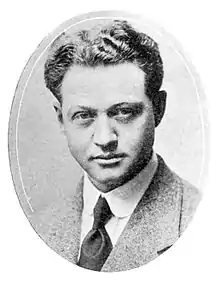 Larry Trimble in 1916 | |
| Born | Laurence Norwood Trimble February 15, 1885 |
| Died | February 8, 1954 (aged 68) |
| Occupations |
|
| Years active | 1910–1926 |
| Era | Silent film |
| Spouses |
|
| Partner | Jane Murfin (c. 1920–1925) |
| Children | 1 |
Laurence Norwood Trimble (February 15, 1885 – February 8, 1954) was an American silent film director, writer and actor. Trimble began his film career directing Jean, the Vitagraph Dog, the first canine to have a leading role in motion pictures. He made his acting debut in the 1910 silent Saved by the Flag, directed scores of films for Vitagraph and other studios, and became head of production for Florence Turner's independent film company in England (1913–1916). Trimble was most widely known for his four films starring Strongheart, a German Shepherd dog he discovered and trained that became the first major canine film star. After he left filmmaking he trained animals exclusively, particularly guide dogs for the blind.
Biography
Laurence Norwood Trimble was born February 15, 1885, in Robbinston, Maine.[1][2] He grew up on a rocky farm near the Bay of Fundy. "I wanted a dog more than anything, but my family could not afford to let me have one," he later wrote. "By the time I had worked my way through school I had owned a number of dogs. Mostly they had bad reputations and nobody else wanted them, but I loved them and learned from them."[3]
Trimble began to write adventure fiction, and sold an animal story to a New York magazine in about 1908.[4]: 139 In 1909, he visited Vitagraph Studios in New York while doing research for a series of articles called "How Movies Are Made". As he chatted with the sole assistant working under Rollin S. Sturgeon, head of the scenario department, he learned that a story of special interest to producer Albert E. Smith had been set aside because it required a dog that could act—not simply do tricks, but to behave naturally on command. Trimble scanned the script and said he could train any dog to do what was needed.[5]: 44
Trimble asked if there were any dogs around, and was told about a stray that hid in the garage and came out only to snatch scraps left by members of the crew. Trimble spent an hour coaxing the frightened dog out of hiding, and another half-hour winning his confidence. Smith was brought in and saw the dog perform the action the script required. "Your dog is wonderful," Smith told Trimble, "but he's too small"—and he explained that it would be impossible to see a small dog in medium shots, one of Vitagraph's filmmaking innovations. "Oh, he isn't my dog," Trimble replied. He told Smith that the little dog was a stray, suggested that he take him home as a pet, and said, "Tomorrow I'll bring you the right dog for the picture." The next morning Trimble arrived with his dog, a tri-color Scotch Collie named Jean.[5]: 44–46 [3] "Jean, the Vitagraph Dog" became the first canine to have a leading role in motion pictures.[4]: 139
Trimble began his film career at Vitagraph in the spring of 1910.[6] He became one of the studio's leading directors, responsible for all of Jean's films and most of those made by Florence Turner, John Bunny[4]: 139 and Flora Finch.[7]
Trimble was married to concert singer Louise Trenton;[lower-alpha 1] their daughter, Janet, was born in September 1912.[9]
In March 1913, Trimble and Jean resigned from Vitagraph, along with actor Tom Powers and Florence Turner. They went to England, where Turner formed her own company with studios at Walton-on-Thames.[4]: 36 Trimble later explained that they went to England because in 1913 "the power of large companies [in the U.S.] left slight opportunity for an independent producer with small capital."[4]: 37 Already famous from her Vitagraph films, Turner introduced herself to British audiences with a personal appearance at the London Pavilion on May 26, 1913.[4]: 36 She and Trimble then toured Britain for the next six weeks, appearing together in 160 venues.[10]
Trimble was head of production at Turner Films,[4]: 36 released by Cecil Hepworth, and over the next three years he wrote and directed some of Britain's most highly regarded films of the period.[7] They included Rose of Surrey (1913), described by The Bioscope as "one of the most charming English film comedies ever produced"; My Old Dutch (1915), which The Moving Picture World called "a rare picture, great in its simplicity, strong in its appeal, and splendidly played by its two principals"; and Far from the Madding Crowd (1915).[4]: 37
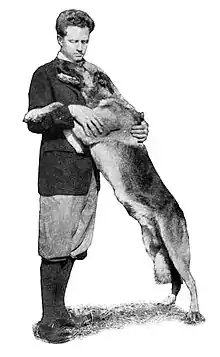
In August 1916, Trimble left his wife in England and returned to the U.S.[4]: 38 with his daughter[9] and his canine star Jean, who died later that year.[4]: 139 In Hollywood from 1917, Trimble joined the newly formed Goldwyn Pictures.[6] He directed Fool's Gold (1919), an independent production partially filmed in the Cascade Mountains in Washington state, in which Turner tried to return to starring roles in American motion pictures.[11][12] In 1920 Trimble directed three features for Selznick Pictures—notably, the last two films made by Olive Thomas before her death.[13][14]
Knowing what qualities a dog needs to be a success in motion pictures — particularly the ability to register feelings that actual conditions do not warrant — Trimble set out to select a German Shepherd dog for his next canine actor. After extensive research he narrowed the field to three specific dogs, one of them in Germany and two in the U.S.[15] In the autumn of 1920, Trimble found a dog at a kennel in White Plains, New York.[16][17] Etzel von Oeringen was a male German Shepherd born in 1917.[18] He was trained in Berlin as a police dog and served in the German Red Cross during World War I.[19] At age three the dog was brought to the United States to be sold. Trimble recognized Etzel's potential and persuaded Jane Murfin, a screenwriter for his films, to buy the dog.[20] A new name, Strongheart, was suggested by the publicity department of First National Pictures, which released his first film.[21]

Strongheart became the first major canine film star.[22][23] Trimble trained the dog and directed him in four rugged outdoor adventure pictures that were shot on location: The Silent Call (1921), Brawn of the North (1922), The Love Master (1924) and White Fang (1925).[24] The partnership between Trimble and Murfin faltered; after their breakup,[lower-alpha 2] Strongheart's death[19] and the loss of most of his investments in the Wall Street Crash of 1929,[26] Trimble retired from filmmaking and trained animals exclusively.[22] He was able to keep McDonald Island, an island he had purchased on the Saint Lawrence River,[26] and in February 1930 he began writing an occasional feature "about dogs, horses, and other people" for The American Boy magazine.[27]
Trimble's special interest was training guide dogs for the blind.[26] He became president of the dog education foundation that supplied dogs for the Hazel Hurst Foundation of Monrovia, California, and spoke to clubs and community service organizations about the work of the foundation and the need for service dogs. The Hazel Hurst Foundation educated and found employment for the blind, including injured war veterans, and trained German Shepherds as assistance dogs that were given free to each student. By August 1944 the school had supplied the Lockheed-Vega Aircraft Corporation with 300 workers, greatly needed for production work during World War II.[28][29]
In 1941, Trimble married Marian Constance Blackton, a daughter of J. Stuart Blackton, one of the founders of Vitagraph Studios. In her personal biography of her father, Marian Blackton Trimble recalled watching Trimble work with Jean on location in 1909: "If any member of the company had stepped out of the group that sunny morning and pointing a finger first at Larry Trimble and then at the producer's scrawny, eight-year-old daughter and said, 'These two will be married one day,' we would have thought it the prophecy of a lunatic. For myself I would have protested hotly that I would never marry a man with red hair."[5]: 48 "It was a second marriage for them both," wrote film historian Anthony Slide, "a loving and constant relationship."[4]: 139
In 1950, the Los Angeles Times reported on one of the presentations on dog training that Trimble gave to Sunday-school classes. He would take his one-year-old German Shepherd, Bambi, or one of his other five dogs, and tell the children about dogs and how to care for them. He told this particular group of young people at Mount Hollywood Congregational Church how he made friends with dogs, and how dogs could help them make friends with other people.[30]
"A dog has no politics or religion, so you can tell people about him freely, and when you have finished you have talked to them about themselves", Trimble said. "I can tell more about people from what they say about their dogs than from what they say about themselves."[30]
Trimble died from a heart ailment on February 8, 1954, a week before his 69th birthday, at the Motion Picture Country House and Hospital in Woodland Hills, California.[22]
Accolades
Trimble was inducted into the Hollywood Walk of Fame on February 8, 1960. His star is located at 6340 Hollywood Boulevard.[31]
Select filmography
Larry Trimble served as director of these motion pictures unless otherwise noted.
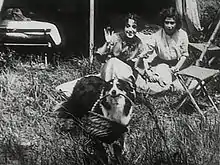

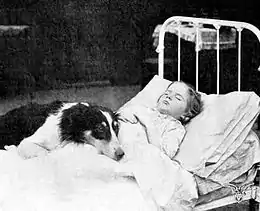
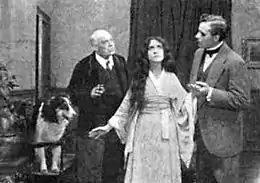

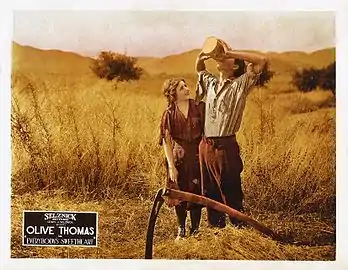
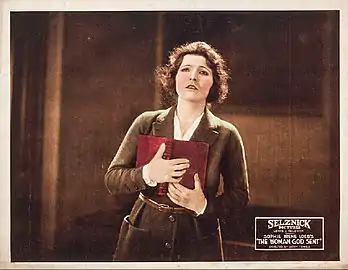




| Year | Title | Notes |
|---|---|---|
| 1910 | Saved by the Flag | Short film,[4]: 144 actor only[7] |
| 1910 | Her Mother's Wedding Gown | Short film featuring Jean[32] |
| 1910 | Jean and the Calico Doll | Short film starring Jean[4]: 145 |
| 1910 | Jean the Match-Maker | Short film starring Jean[4]: 145 |
| 1910 | Auld Robin Grey | Short film[33][34] |
| 1910 | Jean Goes Foraging | Short film starring Jean[4]: 145 |
| 1910 | Jean Goes Fishing | Short film starring Jean[4]: 145 |
| 1910 | A Tin-Type Romance | Short film starring Jean[4]: 146 |
| 1910 | Jean and the Waif | Short film starring Jean[4]: 147 |
| 1910 | Where the Winds Blow | Short film starring Jean[32] |
| 1911 | Jean Rescues | Short film starring Jean[4]: 147 |
| 1911 | When the Light Waned | Short film starring Jean[32] |
| 1911 | Red Eagle | Short film[34] |
| 1911 | The Prejudice of Pierre Marie | Short film[4]: 149 [35] |
| 1911 | The Battle Hymn of the Republic | Short film[4]: 150 |
| 1911 | In the Arctic Night | Short film[34] |
| 1911 | Man to Man | Short film[4]: 151 [36] |
| 1911 | Her Crowning Glory | Short film[4]: 151 [37][38] |
| 1911 | Wig Wag | Short film[4]: 152 |
| 1911 | Auld Lang Syne | Short film starring Jean[4]: 145 [32] |
| 1911 | Hypnotizing the Hypnotist | Short film[4]: 154 |
| 1911 | One Touch of Nature | Short film[4]: 154 |
| 1912 | Jean Intervenes | Short film starring Jean[4]: 155 |
| 1912 | Playmates | Short film starring Jean[4]: 156 [39] |
| 1912 | Cardinal Wolsey | Short film[4]: 156 co-directed with J. Stuart Blackton[34] |
| 1912 | The French Spy | Short film[7][40] |
| 1912 | Bunny and the Dogs | Short film[34] |
| 1912 | Bunny's Suicide | Short film[4]: 161 [34] |
| 1912 | Bachelor Buttons | Short film featuring Jean[4]: 162 [41] |
| 1912 | Bunny All at Sea | Short film[4]: 44, 162 |
| 1912 | Bunny at the Derby | Short film[4]: 163 |
| 1912 | Michael McShane, Matchmaker | Short film[4]: 163 |
| 1912 | Cork and Vicinity | Short film[4]: 165 |
| 1912 | The Signal of Distress | Short film featuring Jean[4]: 165 [42] |
| 1913 | The Wings of a Moth | Short film[4]: 166 |
| 1913 | Everybody's Doing It | Short film[4]: 167 |
| 1913 | Views of Ireland | Short film[4]: 169 |
| 1913 | The House in Suburbia | Short film[4]: 170 |
| 1913 | The Blarney Stone | Short film, also screenwriter[4]: 171 [34] |
| 1913 | Checkmated | Short film[4]: 171 |
| 1913 | Let 'em Quarrel | Short film[4]: 171 |
| 1913 | Jean and Her Family | Short film starring Jean[4]: 172 |
| 1913 | There's Music in the Hair | Short film[4]: 172 |
| 1913 | A Window on Washington Park | Short film[4]: 173 |
| 1913 | Counsellor Bobby | Short film[4]: 174 |
| 1913 | Up and Down the Ladder | Short film[4]: 174 |
| 1913 | Cutey Plays Detective | Short film[4]: 175 |
| 1913 | Does Advertising Pay? | Short film[4]: 176 |
| 1913 | Pickwick Papers | Also screenwriter[4]: 180 [34] |
| 1913 | Pumps | Short film[4]: 180 |
| 1913 | The Deerslayer | Short film co-directed with Hal Reid[34] |
| 1913 | Rose of Surrey | Short film, first release of Turner Films[34] |
| 1913 | The Harper Mystery | Short film, also screenwriter[34] |
| 1913 | Jean's Evidence | Short film starring Jean, also screenwriter and actor[34] |
| 1913 | The Harper Mystery | Short film, also screenwriter[34] |
| 1913 | The Lucky Stone | Short film[34] |
| 1913 | The Younger Sister | Short film[34] |
| 1914 | The Awakening of Nora | Short film[34] |
| 1914 | Creatures of Habit | Short film, also screenwriter[34] |
| 1914 | Daisy Doodad's Dial | Short film, actor only[34] |
| 1914 | Film Favourites | Short film, also cast member[34] |
| 1914 | Flotilla the Flirt | Short film, also screenwriter[34] |
| 1914 | For Her People | Short film, also screenwriter[34] |
| 1914 | The Murdoch Trial | Also actor[34] |
| 1914 | One Thing After Another | Short film, also screenwriter[34] |
| 1914 | Polly's Progress | Short film[34] |
| 1914 | The Shepherd Lassie of Argyle | Short film featuring Jean, also producer[34] |
| 1914 | Shopgirls | [34] |
| 1914 | Through the Valley of Shadows | Also screenwriter[43] |
| 1915 | Alone in London | Also producer[34] |
| 1915 | As Ye Repent | Also screenwriter and actor[34] |
| 1915 | Caste | Also actor[34] |
| 1915 | The Great Adventure | Also screenwriter[34] |
| 1915 | My Old Dutch | [10] |
| 1915 | Lost and Won | [34] |
| 1915 | Far from the Madding Crowd | Also screenwriter[34] |
| 1915 | A Welsh Singer | Screenwriter only[34] |
| 1916 | Doorsteps | Screenwriter only[34] |
| 1916 | Grim Justice | Also screenwriter and actor[34] |
| 1916 | A Place in the Sun | [34] |
| 1916 | Sally in Our Alley | [34] |
| 1917 | The Spreading Dawn | [33] |
| 1917 | The Auction Block | [44] |
| 1918 | The Light Within | [44] |
| 1919 | Fool's Gold | [45] |
| 1919 | Spotlight Sadie | [45] |
| 1920 | Darling Mine | Also screenwriter[45] |
| 1920 | Everybody's Sweetheart | [45] |
| 1920 | The Woman God Sent | [44] |
| 1920 | Going Some | *writer only |
| 1921 | The Silent Call | [33] |
| 1922 | Brawn of the North | Also producer and screenwriter[45] |
| 1924 | The Love Master | Also producer and screenwriter[45] |
| 1924 | Sundown | Co-directed with Harry O. Hoyt[45] |
| 1925 | White Fang | [33] |
| 1926 | My Old Dutch | Also screenwriter[33] |
Notes
- ↑ The marriage of Trimble and Mary Louise Githens on December 31, 1907, was recorded in Manhattan.[8]
- ↑ Film historian Kevin Brownlow described the partnership between Trimble and Murfin as both professional and personal. Although some sources describe them as a husband-and-wife filmmaking team, no marriage has been substantiated.[25]
References
- ↑ Ancestry.com. Maine, Birth Records, 1621–1922 [database on-line]. Provo, UT, USA: Ancestry.com Operations, Inc., 2010. Retrieved 2016-07-29.
- ↑ Ancestry.com. U.S., World War II Draft Registration Cards, 1942 [database on-line]. Provo, UT, USA: Ancestry.com Operations, Inc., 2010. Retrieved 2016-07-29.
- 1 2 Trimble, Larry (February 1930). "About Me and My Friends". The American Boy. Vol. 104, no. 2. p. 49.
- 1 2 3 4 5 6 7 8 9 10 11 12 13 14 15 16 17 18 19 20 21 22 23 24 25 26 27 28 29 30 31 32 33 34 35 36 37 38 39 40 41 42 43 44 45 46 47 48 49 50 51 52 53 Slide, Anthony (1976). The Big V: A History of the Vitagraph Company. Metuchen, N.J.: Scarecrow Press. ISBN 9780810809673.
- 1 2 3 Trimble, Marian Blackton (1985). Slide, Anthony (ed.). J. Stuart Blackton: A Personal Biography by His Daughter. Metuchen, New Jersey: Scarecrow Press. ISBN 9780810817654.
- 1 2 "Biographies of Important Directors". The Film Daily. June 7, 1925. p. 107. Retrieved August 25, 2016.
- 1 2 3 4 Katz, Ephraim (1998). Klein, Fred; Nolen, Ronald Dean (eds.). The Film Encyclopedia (3rd ed.). New York: HarperPerennial. p. 1373. ISBN 0-06-273492-X.
- ↑ Ancestry.com. New York, New York, Marriage Index 1866-1937 [database on-line]. Provo, UT, USA: Ancestry.com Operations, Inc., 2014. Retrieved 2014-08-02.
- 1 2 Brownlow, Kevin (May 31, 1999). "Obituary: Jan Zilliacus". The Independent. Retrieved July 29, 2016.
- 1 2 Slide, Anthony (2015). A Special Relationship: Britain Comes to Hollywood and Hollywood Comes to Britain. Jackson, Mississippi: University Press of Mississippi. ISBN 9781628460872.
- ↑ "Fool's Gold". AFI Catalog of Feature Films. American Film Institute. Retrieved August 24, 2016.
- ↑ "Fool's Gold". Moving Picture World. May 17, 1919. pp. 1076–1077. Retrieved August 24, 2016.
- ↑ "Darling Mine". AFI Catalog of Feature Films. American Film Institute. Retrieved August 24, 2016.
- ↑ "Everybody's Sweetheart". AFI Catalog of Feature Films. American Film Institute. Retrieved August 24, 2016.
- ↑ Trimble, Laurence (1926). Strongheart; The Story of a Wonder Dog. Racine, Wis.: Whitman Publishing Company. OCLC 4451141.
- ↑ Terhune, Albert Payson (September 9, 1928). "Tales of Real Dogs: Strongheart, First Canine Movie Star". The Ogden Standard.
- ↑ "Protection Kennels (advertisement)". The Breeder. The Shepherd Dog Club of America, Inc. 7 (11). November 20, 1920. Retrieved August 1, 2016.
- ↑ "Stud Book Report". The American Kennel Gazette and Stud Book. American Kennel Club. 34 (10): 1076. October 31, 1922. Retrieved August 1, 2016.
- 1 2 "Dog Hero of Films Dies". The New York Times. June 25, 1929. Retrieved July 28, 2016.
- ↑ "The Story of Strongheart". Photoplay. December 1921. pp. 48, 97–98. Retrieved July 30, 2016.
- ↑ "Hollywood Star Walk: Strongheart". Los Angeles Times. Retrieved July 31, 2016.
- 1 2 3 "Laurence Trimble Dies". The New York Times. February 10, 1954. Retrieved November 28, 2015.
- ↑ Lowe, Denise (2014). An Encyclopedic Dictionary of Women in Early American Films: 1895-1930. Routledge. J: Jean. ISBN 9781317718963.
- ↑ "Strongheart". AFI Catalog of Feature Films. American Film Institute. Retrieved August 24, 2016.
- ↑ Buck, Julie (September 27, 2013). "Jane Murfin". Women Film Pioneers Project. Center for Digital Research and Scholarship, Columbia University Libraries. Retrieved July 29, 2016.
- 1 2 3 Taves, Brian (2005). Talbot Mundy, Philosopher of Adventure: A Critical Biography. Jefferson, North Carolina: McFarland. p. 290. ISBN 9780786422340.
- ↑ Trimble, Larry (February 1930). "Jumbo". The American Boy. Vol. 104, no. 2. p. 48.
- ↑ "Seeing Eye Dog Commended; Aid for Sightless Explained to Club". The Corona Daily Independent. Corona, California. August 18, 1944. pp. 1–2.
What the seeing eye dog means to sight-handicapped persons was fully explained today before the Rotary club meeting in the Hotel Springborg, when Larry Trimble spoke on the work of the Hazel Hurst Foundation of Monrovia. According to the speaker, the Hazel Hurst Foundation was started by a donation from a Rotary club in Ogden, N.Y. Miss Hurst, 31 years of age, had the vision of starting the school, he related, which is to educate and help find employment for sightless persons. … Speaking of the dogs, he said they were not sold, but were given free to every student, and if the dogs were abused they were taken back, but this had happened in only one instance. Trimble said that the student pays a dollar a day for his board and room and if he is without funds he is not refused help. The entire work of the foundation, he explained, is carried on by voluntary donations of clubs, societies and various groups. … Trimble stressed the great need for dogs. They have at present between 200 and 250 trained dogs, only using German shepherd breed … They are always in need of dogs and would be glad to have any that someone would like to donate for training.
- ↑ "The Blind Go to War". The Rotarian. Rotary International. November 1943. Retrieved September 1, 2016.
- 1 2 "Film Dog Trainer Tells Children How It's Done". Los Angeles Times. August 19, 1950.
- ↑ "Laurence Trimble". Hollywood Walk of Fame. Hollywood Chamber of Commerce. Retrieved August 8, 2016.
- 1 2 3 4 "Jean". BFI Film & TV Database. British Film Institute. Archived from the original on March 10, 2016. Retrieved July 29, 2016.
- 1 2 3 4 5 "Lawrence Trimble". AFI Catalog of Feature Films. American Film Institute. Retrieved July 28, 2016.
- 1 2 3 4 5 6 7 8 9 10 11 12 13 14 15 16 17 18 19 20 21 22 23 24 25 26 27 28 29 30 31 32 33 34 35 36 37 "Larry Trimble". BFI Film & TV Database. British Film Institute. Archived from the original on September 15, 2016. Retrieved July 28, 2016.
- ↑ "Prejudice of Pierre Marie". TCM Database. Turner Classic Movies. Retrieved July 29, 2016.
- ↑ "Man to Man". TCM Database. Turner Classic Movies. Retrieved July 29, 2016.
- ↑ "The Film Parade (1933); Vitagraph Treasures". UCLA Film and Television Archive. Retrieved August 4, 2016.
- ↑ "Her Crowning Glory". TCM Database. Turner Classic Movies. Retrieved July 29, 2016.
- ↑ "A Quartette That Will Pack Your Halls". Cinema News and Property Gazette. April 1912. Retrieved July 29, 2016.
- ↑ "A Spy Film". Cinema News and Property Gazette. October 1912. Retrieved July 29, 2016.
- ↑ "Marlow Theater". Suburbanite Economist. October 4, 1912. p. 3.
- ↑ "The Signal of Distress". The Cinema News and Property Gazette. February 12, 1913. Retrieved August 6, 2016.
- ↑ "Through the Valley of Shadows". BFI Film & TV Database. British Film Institute. Archived from the original on September 15, 2016. Retrieved July 31, 2016.
- 1 2 3 "Larry Trimble". AFI Catalog of Feature Films. American Film Institute. Retrieved July 28, 2016.
- 1 2 3 4 5 6 7 "Laurence Trimble". AFI Catalog of Feature Films. American Film Institute. Retrieved July 28, 2016.
External links
- Laurence Trimble at IMDb
- "Flashback: New England Director Larry Trimble", Imagine News Magazine (March 2000)
